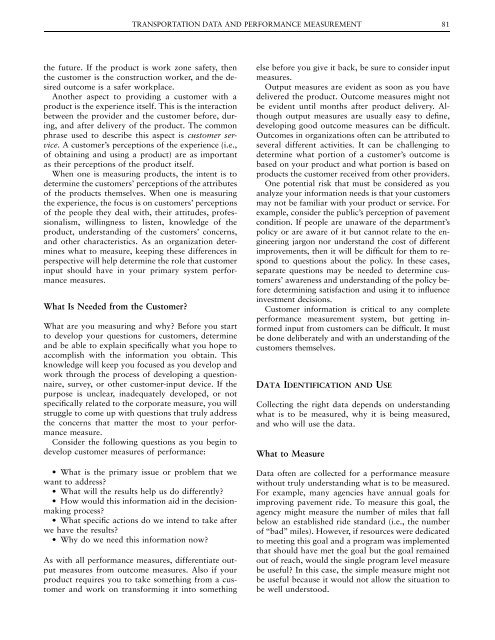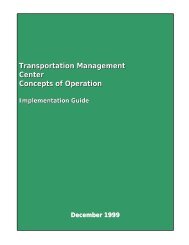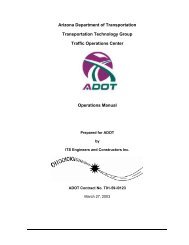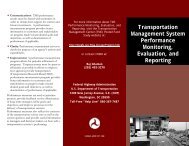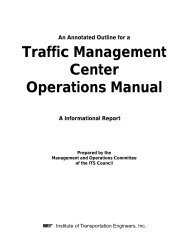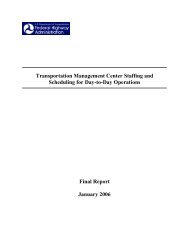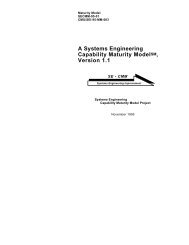80 PERFORMANCE MEASURES TO IMPROVE TRANSPORTATION SYSTEMS AND AGENCY OPERATIONSTABLE 2Traditional MeasuresTraditional and Customer MeasuresQuantitative measuresRoutinely collectedDefine condition or use of facility or serviceOne measure for each featureCustomer MeasuresQualitative measuresCapture perceptionsDefine prioritiesDefine how much is importantMay result in conflicting answerssessment of quality, help to assign a priority to variousissues, or help define how much of a given itemis important (Table 2).Customer measures are an important componentin an organization’s family of measures. They differfrom traditional measures in that they are based onpeople’s perceptions of the products and services deliveredto them. Because no two people are the same,perceptions of the same thing can vary widely. Also,one person’s perceptions about something can changefrom one point in time to another. This is quite differentfrom traditional measurements. Fortunately,valid and reliable methods for measuring customers’perceptions allow organizations to use this valuableinformation to improve performance.Who Is the Customer?When an organization is using customer measures tohelp define its performance successes and improvementneeds, a clear understanding of its customers isvital. A customer can be defined simply as the useror recipient of a product or service. Because there islikely to be more than one user of a given productor service, users are often referred to as customergroups. It is important to look for similarities in anddifferences between customer groups because theywill affect the findings.As the number of customers in a customer groupincreases, more and more differences between individualsin the group become evident, resulting in evenmore distinct customer groups or subgroups. Thus, atransportation agency with many products and servicescould have many customer groups, each ofwhich has different needs, expectations, and perceptions.In agencies with many products and services anda wide range of customers, different customers probablyhave competing or even opposing needs. Howdoes an organization determine which action to takewhen two customer groups have opposite opinionsof the service they have received? It might be possibleto accommodate both groups, but if not, what then?As discussed above, the understanding of the differencesbetween the customers and customer groupsand having a clearly defined purpose will greatly helpin the making of this determination. Also, factorssuch as resource capacity and economies of scale willaffect the actions the organization can take. It is importantto point out here that all customers are notcreated equal. Some key customers may be frequentusers of the highway system (commuters); others maybe large-volume users (truckers); others may be importantbecause they have political or some othertype of influence. Key customer groups should alwaysbe measured for their needs, expectations, and levelsof satisfaction.In many organizations, simply defining the customercan be a challenge. For instance, when a statetrooper stops a motorist for speeding in a constructionzone, who is the customer—the stopped motorist,the construction workers, the residents nearby,other drivers, the taxpayers, or the legislature? Theanswer could be any or all of these. It depends onhow the agency defines what is being provided andwhat the goals are. The agency must clearly understandwhat is provided, how it fits into the overallobjective, and why it should be measured before aperformance measure can be developed with customerinput.How Does the Customer Relate to the Measure?A customer is a user of the system or someone whobenefits from the system. A product, then, can be definedas anything you provide to a person or groupof people. Using this definition, a product can be oneof two types: a tangible, visible thing, such as a licenseplate or a highway interchange, or an intangiblething, such as information about traffic laws in aconstruction zone or an analysis of how legislationaffecting commercial trucking affects highway use. Inthe construction zone example, if the product is thestate trooper’s speeding ticket, then the customer isthe driver, and the desired outcome is the driver’s alteredbehavior when driving through work zones in
TRANSPORTATION DATA AND PERFORMANCE MEASUREMENT 81the future. If the product is work zone safety, thenthe customer is the construction worker, and the desiredoutcome is a safer workplace.Another aspect to providing a customer with aproduct is the experience itself. This is the interactionbetween the provider and the customer before, during,and after delivery of the product. The commonphrase used to describe this aspect is customer service.A customer’s perceptions of the experience (i.e.,of obtaining and using a product) are as importantas their perceptions of the product itself.When one is measuring products, the intent is todetermine the customers’ perceptions of the attributesof the products themselves. When one is measuringthe experience, the focus is on customers’ perceptionsof the people they deal with, their attitudes, professionalism,willingness to listen, knowledge of theproduct, understanding of the customers’ concerns,and other characteristics. As an organization determineswhat to measure, keeping these differences inperspective will help determine the role that customerinput should have in your primary system performancemeasures.What Is Needed from the Customer?What are you measuring and why? Before you startto develop your questions for customers, determineand be able to explain specifically what you hope toaccomplish with the information you obtain. Thisknowledge will keep you focused as you develop andwork through the process of developing a questionnaire,survey, or other customer-input device. If thepurpose is unclear, inadequately developed, or notspecifically related to the corporate measure, you willstruggle to come up with questions that truly addressthe concerns that matter the most to your performancemeasure.Consider the following questions as you begin todevelop customer measures of performance:• What is the primary issue or problem that wewant to address?• What will the results help us do differently?• How would this information aid in the decisionmakingprocess?• What specific actions do we intend to take afterwe have the results?• Why do we need this information now?As with all performance measures, differentiate outputmeasures from outcome measures. Also if yourproduct requires you to take something from a customerand work on transforming it into somethingelse before you give it back, be sure to consider inputmeasures.Output measures are evident as soon as you havedelivered the product. Outcome measures might notbe evident until months after product delivery. Althoughoutput measures are usually easy to define,developing good outcome measures can be difficult.Outcomes in organizations often can be attributed toseveral different activities. It can be challenging todetermine what portion of a customer’s outcome isbased on your product and what portion is based onproducts the customer received from other providers.One potential risk that must be considered as youanalyze your information needs is that your customersmay not be familiar with your product or service. Forexample, consider the public’s perception of pavementcondition. If people are unaware of the department’spolicy or are aware of it but cannot relate to the engineeringjargon nor understand the cost of differentimprovements, then it will be difficult for them to respondto questions about the policy. In these cases,separate questions may be needed to determine customers’awareness and understanding of the policy beforedetermining satisfaction and using it to influenceinvestment decisions.Customer information is critical to any completeperformance measurement system, but getting informedinput from customers can be difficult. It mustbe done deliberately and with an understanding of thecustomers themselves.DATA IDENTIFICATION AND USECollecting the right data depends on understandingwhat is to be measured, why it is being measured,and who will use the data.What to MeasureData often are collected for a performance measurewithout truly understanding what is to be measured.For example, many agencies have annual goals forimproving pavement ride. To measure this goal, theagency might measure the number of miles that fallbelow an established ride standard (i.e., the numberof ‘‘bad’’ miles). However, if resources were dedicatedto meeting this goal and a program was implementedthat should have met the goal but the goal remainedout of reach, would the single program level measurebe useful? In this case, the simple measure might notbe useful because it would not allow the situation tobe well understood.
- Page 5 and 6:
National Academy of SciencesNationa
- Page 7 and 8:
Workshop Summary ..................
- Page 9:
General OverviewIntroductionExecuti
- Page 12 and 13:
4 PERFORMANCE MEASURES TO IMPROVE T
- Page 14 and 15:
6 PERFORMANCE MEASURES TO IMPROVE T
- Page 18 and 19:
10 PERFORMANCE MEASURES TO IMPROVE
- Page 20 and 21:
12 PERFORMANCE MEASURES TO IMPROVE
- Page 23:
Linking Performance Measures withDe
- Page 26 and 27:
18 PERFORMANCE MEASURES TO IMPROVE
- Page 28 and 29:
20 PERFORMANCE MEASURES TO IMPROVE
- Page 30 and 31:
22 PERFORMANCE MEASURES TO IMPROVE
- Page 32 and 33:
24 PERFORMANCE MEASURES TO IMPROVE
- Page 34 and 35:
26 PERFORMANCE MEASURES TO IMPROVE
- Page 36 and 37:
28 PERFORMANCE MEASURES TO IMPROVE
- Page 38 and 39: 30 PERFORMANCE MEASURES TO IMPROVE
- Page 40 and 41: 32 PERFORMANCE MEASURES TO IMPROVE
- Page 42 and 43: Panel DiscussionJohn Poorman, Capit
- Page 44 and 45: 36 PERFORMANCE MEASURES TO IMPROVE
- Page 46 and 47: 38 PERFORMANCE MEASURES TO IMPROVE
- Page 48 and 49: Workshop SummaryJohn Basilica, Loui
- Page 50 and 51: 42 PERFORMANCE MEASURES TO IMPROVE
- Page 52 and 53: 44 PERFORMANCE MEASURES TO IMPROVE
- Page 55 and 56: RESOURCE PAPERImplementing Performa
- Page 57 and 58: IMPLEMENTING PERFORMANCE MEASUREMEN
- Page 59 and 60: IMPLEMENTING PERFORMANCE MEASUREMEN
- Page 61 and 62: IMPLEMENTING PERFORMANCE MEASUREMEN
- Page 63 and 64: IMPLEMENTING PERFORMANCE MEASUREMEN
- Page 65 and 66: IMPLEMENTING PERFORMANCE MEASUREMEN
- Page 67 and 68: Panel DiscussionJennifer Finch, Col
- Page 69 and 70: FIGURE 2Level of measures and align
- Page 71 and 72: PANEL DISCUSSION: AGENCY IMPLEMENTA
- Page 73 and 74: PANEL DISCUSSION: AGENCY IMPLEMENTA
- Page 75 and 76: PANEL DISCUSSION: AGENCY IMPLEMENTA
- Page 77 and 78: PANEL DISCUSSION: AGENCY IMPLEMENTA
- Page 79 and 80: WORKSHOP SUMMARY: AGENCY IMPLEMENTA
- Page 81: Selecting Measures, Data Needs, and
- Page 84 and 85: 76 PERFORMANCE MEASURES TO IMPROVE
- Page 86 and 87: 78 PERFORMANCE MEASURES TO IMPROVE
- Page 90 and 91: 82 PERFORMANCE MEASURES TO IMPROVE
- Page 92 and 93: 84 PERFORMANCE MEASURES TO IMPROVE
- Page 94 and 95: 86 PERFORMANCE MEASURES TO IMPROVE
- Page 96 and 97: Panel Discussion, Part 1Anita Vande
- Page 98 and 99: 90 PERFORMANCE MEASURES TO IMPROVE
- Page 100 and 101: 92 PERFORMANCE MEASURES TO IMPROVE
- Page 102 and 103: Panel Discussion, Part 2Douglas Zim
- Page 104 and 105: FIGURE 11 Example data
- Page 106 and 107: 98 PERFORMANCE MEASURES TO IMPROVE
- Page 108 and 109: Workshop SummaryBrenda Berg, Trans
- Page 110 and 111: 102 PERFORMANCE MEASURES TO IMPROVE
- Page 113 and 114: RESOURCE PAPERMeasuring That Which
- Page 115 and 116: MEASURING THAT WHICH CANNOT BE MEAS
- Page 117 and 118: TABLE 1Sustainability MeasuresNewma
- Page 119 and 120: MEASURING THAT WHICH CANNOT BE MEAS
- Page 121 and 122: MEASURING THAT WHICH CANNOT BE MEAS
- Page 123 and 124: MEASURING THAT WHICH CANNOT BE MEAS
- Page 125 and 126: MEASURING THAT WHICH CANNOT BE MEAS
- Page 127 and 128: MEASURING THAT WHICH CANNOT BE MEAS
- Page 129 and 130: MEASURING THAT WHICH CANNOT BE MEAS
- Page 131 and 132: MEASURING THAT WHICH CANNOT BE MEAS
- Page 133 and 134: MEASURING THAT WHICH CANNOT BE MEAS
- Page 135 and 136: PANEL DISCUSSION: CONNECTING SYSTEM
- Page 137 and 138: PANEL DISCUSSION: CONNECTING SYSTEM
- Page 139 and 140:
PANEL DISCUSSION: CONNECTING SYSTEM
- Page 141 and 142:
PANEL DISCUSSION: CONNECTING SYSTEM
- Page 143 and 144:
Workshop SummaryScott Bassett, Oreg
- Page 145:
Freight Performance MeasuresCurrent
- Page 148 and 149:
140 PERFORMANCE MEASURES TO IMPROVE
- Page 150 and 151:
142 PERFORMANCE MEASURES TO IMPROVE
- Page 152 and 153:
144 PERFORMANCE MEASURES TO IMPROVE
- Page 154 and 155:
146 PERFORMANCE MEASURES TO IMPROVE
- Page 156 and 157:
148 PERFORMANCE MEASURES TO IMPROVE
- Page 158 and 159:
150 PERFORMANCE MEASURES TO IMPROVE
- Page 160 and 161:
152 PERFORMANCE MEASURES TO IMPROVE
- Page 163 and 164:
APPENDIX ASummaries of 20 Poster Se
- Page 165 and 166:
SUMMARIES OF 20 POSTER SESSIONS 157
- Page 167 and 168:
TABLE 1(continued) WSDOT Outcomes,
- Page 169 and 170:
SUMMARIES OF 20 POSTER SESSIONS 161
- Page 171 and 172:
SUMMARIES OF 20 POSTER SESSIONS 163
- Page 173 and 174:
SUMMARIES OF 20 POSTER SESSIONS 165
- Page 175 and 176:
SUMMARIES OF 20 POSTER SESSIONS 167
- Page 177 and 178:
FIGURE 2 Sacramento Regional Transi
- Page 179 and 180:
FIGURE 3Goal evaluation table: Chit
- Page 181 and 182:
SUMMARIES OF 20 POSTER SESSIONS 173
- Page 183 and 184:
SUMMARIES OF 20 POSTER SESSIONS 175
- Page 185 and 186:
SUMMARIES OF 20 POSTER SESSIONS 177
- Page 187 and 188:
TABLE 6Mobility Performance Measure
- Page 189 and 190:
SUMMARIES OF 20 POSTER SESSIONS 181
- Page 191 and 192:
SUMMARIES OF 20 POSTER SESSIONS 183
- Page 193 and 194:
SUMMARIES OF 20 POSTER SESSIONS 185
- Page 195 and 196:
FIGURE 13 MPAH lane-miles by roadwa
- Page 197 and 198:
SUMMARIES OF 20 POSTER SESSIONS 189
- Page 199 and 200:
SUMMARIES OF 20 POSTER SESSIONS 191
- Page 201 and 202:
SUMMARIES OF 20 POSTER SESSIONS 193
- Page 203 and 204:
SUMMARIES OF 20 POSTER SESSIONS 195
- Page 205 and 206:
SUMMARIES OF 20 POSTER SESSIONS 197
- Page 207 and 208:
SUMMARY OF PEER EXCHANGE ON DATA FO
- Page 209 and 210:
SUMMARY OF PEER EXCHANGE ON DATA FO
- Page 211 and 212:
SUMMARY OF PEER EXCHANGE ON DATA FO
- Page 213 and 214:
SUMMARY OF PEER EXCHANGE ON DATA FO
- Page 215 and 216:
SUMMARY OF PEER EXCHANGE ON DATA FO
- Page 217 and 218:
SUMMARY OF PEER EXCHANGE ON DATA FO
- Page 219 and 220:
SUMMARY OF PEER EXCHANGE ON DATA FO
- Page 221 and 222:
SUMMARY OF PEER EXCHANGE ON DATA FO
- Page 223 and 224:
APPENDIX C: RESEARCH STATEMENTS DEV
- Page 225 and 226:
LIST OF PARTICIPANTS 217University,
- Page 227:
LIST OF PARTICIPANTS 219Darwin Stua


